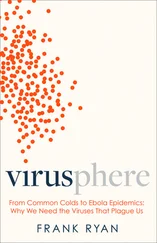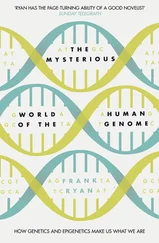If we turn our attentions to the behavioural symbioses of the cleaner stations, once again we see that these involve important changes in behaviour for both predators and cleaners: the predators put aside hunger and aggression, while the cleaner fish and tiny shrimps put aside fear and the instinct to flee. Such dramatic changes of behaviour in predator and potential prey would have to be hardwired into the genomes of the interacting partners and, just as we have seen with the hummingbirds and their floral partners, this involves each of the partners changing its behaviour in relation to the other. Once again we see selection operating at the level of the partnership in a mutualistic symbiosis. This also raises important questions about the real nature of viruses and their hosts. Could it be that selection might also be operating at the level of the virus-host interaction? If so, at what stage in the interaction did selection switch from operating at selfish, individual, even selfish gene, level, to recognise and begin to operate at this profoundly important level? This very question was addressed by the eminent evolutionary biologist, John Maynard Smith, late professor at the University of Sussex, and widely acclaimed as a pioneering Modern Darwinian.
In a chapter in the multi-authored book, Symbiosis as a Source of Evolutionary Innovation , which was edited by Lynn Margulis and René Fester, Maynard Smith developed a very interesting extrapolation of the Darwinian view of symbiosis. Believing that symbiosis played an important part in three of the five major transitions of life, he nevertheless insisted that there was no reason for symbiosis to challenge the neo-Darwinian view of evolution. But he also believed that, in order to accommodate the partnership aspects of symbiosis, there were circumstances in which natural selection must operate at a different level in symbiosis when compared with how it operates in the many Darwinian extrapolations.
It was even more helpful when, in exploring this further, he examined symbioses involving a microbial symbiont and a more complex host, and these he divided into various sub-categories. Where the symbiont could survive and reproduce independently of the host, this would suggest an evolution along conventional “selfish” Darwinian lines. But where the symbiont cannot survive without the host, and most particularly where the symbiont is dependent on the host for reproduction – a condition Maynard Smith termed “direct transmission” – the role of natural selection would inevitably change. Viruses can never survive, or reproduce, without their hosts. In this respect, viruses are said to be obligate parasites, so we should not be too surprised to discover that Maynard Smith included viruses in his discussion of symbionts that were only capable of reproduction through direct transmission.
In his words:
With direct transmission, the genes of the symbiont will leave descendants only to the extent that the host survives and reproduces. In general, therefore, mutations in the genes of the symbiont will be established by selection only if they increase the fitness of the host . 9
When he writes that “mutations … will be established by selection”, he is referring to evolution taking place in the conventional Darwinian sense. Or to put it simply, the symbiont – the virus in virus-host interactions – will only be honed by mutation-plus-selection in a manner that increases the fitness of the host. In other words, the virus is now responding to the presence, and needs, of its symbiotic partner.
This interpretation of symbiosis, as seen from a Darwinian perspective, provides an important measure of common ground between the two disciplines. As we have seen in the examples of the hummingbirds and the cleaner stations, a symbiologist might adopt a slightly different perspective, regarding both host and parasite as symbionts, so that, rather than merely looking at the relationship from a single perspective, the symbiologist would examine how this might apply to the partnership. And all the evidence from what is now a weighty world of symbiology, with its study of a vast array of such partnerships, would imply that in microbe-host partnerships each of the partners responds to the presence of the other – or to put it from an evolutionary perspective, selection will be seen to operate, to a significant degree, at the level of the partnership. This perspective is seen to operate throughout all the levels of symbiosis, and, in the evolutionary sense, to symbiogenesis, whether at behavioural, metabolic or genetic level.
Within the genetic symbioses, there are examples of sudden and major change, where the genomes of radically different life forms unite to form a single novel, holobiontic, genome. 10In this very dramatic situation, which has the potential to give rise to very rapid evolutionary change, it is inevitable that selection will operate, to significant degree, at the level of the new holobiontic genome. It is perhaps not altogether surprising that some biologists see an irrevocable chasm in the evolutionary dynamics of this most powerful of genetic symbiosis and the gradualism that is assumed to be central to Darwinian evolution. But Maynard Smith does not agree. He goes on to emphasise that there is no contradiction between Darwin’s belief that complex adaptations arise by the natural selection of numerous intermediates, and the possibility that new evolutionary potentialities may arise suddenly if genetic material that has been programmed by selection in different ancestral lineages is brought together by symbiosis .
This is important not only in offering the potential of reconciling the dynamics of Darwinian and symbiotic evolution, but also in interpreting the role of symbiotic viruses in our human evolution.
In the summer of 1985, when a movie star was diagnosed with the disease … the AIDS epidemic became palpable and the threat loomed everywhere. Suddenly there were children with AIDs who wanted to go to school, laborers with AIDS who wanted to go to work … By the time America paid attention to the disease … the virus was already pandemic to the nation .
RANDY SHILTS 1
Viruses have caused some of the great epidemics that project like tombstones through the fabric of human history. The quotation above is from the prologue of a book that chronicles the arrival of the AIDS pandemic in America, and the ensuing hue and cry of blame, prejudice, bewilderment, laudable dedication on the part of a few doctors and scientists and heartbreaking failings on the part of some politicians and key institutions, all conspiring to delay or limit the necessary response. It might seem counter-intuitive for me to suggest that even from such a grotesque tragedy we have discovered an important level of enlightenment. But this is speaking with hindsight and few, if any, understood the implications of this new, and utterly alien, organism when it first arrived on American shores in 1978.
In time we noted how, unlike smallpox, or pandemic influenza, the symptoms of AIDS conspired to mask its very arrival. It came among us stealthily, almost silently: the first entry of the virus into a new victim was all too often unrecognised, causing no more than a mild rash or fever – in half its victims causing no symptoms at all. After invasion, the virus continued to mask its presence, often hiding for years inside the blood cells known as lymphocytes, so that its victims remained none the wiser. Yet, even while hiding, it could be transmitted to other victims, through blood, through other bodily fluids, and particularly through sexual intercourse, heterosexual or homosexual. This parasite, and yes, I do suggest, aggressive symbiotic partner, is devoid of pity or prejudice, embracing all races, all ages from newborn to senility, and either gender. Meanwhile, throughout its period of silent invasion, the virus mutates at an extraordinary speed inside each infected person so that, some two or three years after first infection, the original strain of virus is no longer recognisable amongst the competing swarms of millions of different mutating progeny.
Читать дальше












